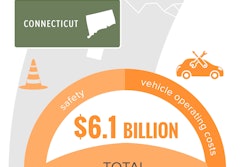Sens. Mark R. Warner (D-Virginia) and Roy Blunt (R-Missouri) are proposing legislation that would help leverage private funding for states and localities to use on infrastructure projects.

The BRIDGE Act would set up an “independent, nonpartisan financing authority” to work in concert with existing infrastructure funding. This “authority” would offer loans and loan guarantees to help fund “the most economically viable” infrastructure projects. It would have initial funding up to $10 billion that would be used to “incentivize private sector investment” to potentially make possible $300 billion in “total project investment.” The legislation would structure the authority to be self-sustaining over time.
Warner cites the annual Infrastructure Week in stressing the need for making “real investments” in U.S. infrastructure instead of short-term fixes.
“The BRIDGE Act offers a bold, bipartisan solution to help address our infrastructure needs by incentivizing private investment and pairing it with public resources,” he says. “This legislation will set a clear framework that will help create jobs, expand U.S. commerce and trade, and keep American businesses competitive.”
Co-sponsoring the bill are Sens. Richard Blumenthal (D-Connecticut), Chris Coons (D-Delaware), Kirsten Gillibrand (D-New York), Lindsey Graham (R-South Carolina), Dean Heller (R-Nevada), Amy Klobuchar (D-Minnesota) and Thom Tillis (R-North Carolina).
In supporting the potential measure, president of the American Society of Civil Engineers, Norma Jean Mattei, says the BRIDGE Act would be a step toward “increased, sustained investment” via the funding authority.
“If we are to improve our nation’s infrastructure, graded a D+ in ASCE’s 2017 Infrastructure Report Card, we can no longer afford to defer needed investment in modernization and maintenance,” Mattei says. “Through the BRIDGE Act, our nation’s infrastructure will receive much-needed additional funding to help narrow the $2 trillion infrastructure investment gap that currently costs every American family $3,400 a year out of their discretionary income.”
A summary of the legislation follows:
The Warner-Blunt Building and Renewing Infrastructure for Development and Growth in Employment (BRIDGE) Act will help close America’s widening infrastructure gap, create millions of jobs, and ensure America’s global competitiveness in the 21st century by establishing an Infrastructure Financing Authority to complement existing funding mechanisms and expand overall infrastructure investment. This entity, which would provide loans and loan guarantees, would be both fiscally responsible and robust enough to help address America’s infrastructure deficit.
AMERICA FACES UNPRECEDENTED INFRASTRUCTURE CHALLENGES
Americans using our outdated roads, bridges, airports and water systems confront the need for better infrastructure every day. Businesses experience it too: our economy loses $80 billion annually because of blackouts on outdated grid infrastructure and traffic congestion. Our urban water and sewage systems are also overwhelmed and in ill repair due to aging water infrastructure. The World Economic Forum’s (WEF) Global Competitiveness Report ranked the U.S. outside the top ten (11th) in overall infrastructure out of 138 countries surveyed.
For years, the federal government has struggled to come up with the necessary funding for infrastructure investment. The last surface transportation bill that passed, the FAST Act, provides highway and transit funding for five years. However, it was paid for through siphoning off funds from unrelated programs and estimates show that the Highway Trust Fund will again be broke when the bill lapses. And while the bill provides the Department of Transportation with additional tools to advance innovative financing mechanisms such as the Build America Bureau, much more needs to be done. The outlook for a gas tax increase or other funding fix in the near future is bleak. As a result, the U.S. spends less than 40 percent of what is needed to meet our infrastructure demands and the American Society of Civil Engineers (ASCE) estimates that we will need to invest $4.6 trillion in the next ten years to bring American infrastructure to a state of good repair.
CURRENT FUNDING IS INADEQUATE BUT INNOVATIVE OPPORTUNITIES EXIST
Global pension funds, private equity funds, mutual funds, and sovereign wealth funds are looking to invest hundreds of billions of dollars in high-quality, low-risk infrastructure projects. Unfortunately, those investments are currently not taking place in the United States, where the private sector provides only six percent of the nation’s infrastructure funding.
The BRIDGE Act will change that. This legislation will enable infrastructure investment here in the U.S. by incentivizing private sector investment. It also addresses market gaps, like the absence of long-term lending, which will allow us to dramatically increase private investment in American infrastructure. By effectively leveraging federal funds to partner with private dollars, we can dramatically grow overall domestic infrastructure investment.
AN INDEPENDENT, FISCALLY RESPONSIBLE, PRIVATE-SECTOR DRIVEN SOLUTION
The BRIDGE Act would establish a fiscally responsible Infrastructure Financing Authority (IFA) to complement our existing infrastructure funding through loans and loan guarantees. IFA would be independent of the political process, fund the most important and most economically viable projects nationwide, and incentivize private investment. While IFA would receive initial funding from the government, it would become self-sustaining over time.
KEY PROVISIONS OF THE BRIDGE ACT
Independent, non-partisan operations
- While IFA would be a government‐owned entity, it would operate independent of any federal agency. It would be led by a Chief Executive Officer and a Board of Directors, consisting of seven voting members.
- No more than four voting members of the board could be from the same political party. Strong oversight by Congress and the Federal government
- The Board and CEO would be appointed by the President, with one board member designated as chairperson. All candidates would be confirmed with the advice and consent of the Senate.
- The Majority and Minority Leaders of the Senate, as well as the Speaker and Minority Leader of the House of Representatives would each recommend candidates.
- The Treasury Department’s Inspector General would oversee IFA’s operations for the first five years, an independent auditor would review IFA’s books, and IFA would submit an assessment of the risks of its portfolio, prepared by an independent source. After five years, IFA would have its own dedicated Inspector General.
- The Government Accountability Office (GAO) would also conduct an evaluation of IFA and submit a report to Congress no later than five years after the date of enactment, as well as a second report ten years after enactment. Broad eligibility for infrastructure
- Eligible projects would include transportation infrastructure, water infrastructure, and energy infrastructure in the transmission, distribution and storage sectors.
- Projects must be at least $50 million and be of national or regional significance to qualify. Geographic, infrastructure sector, and size considerations would be taken into account. Unbiased project selection
- Projects must go through rigorous analysis and show clear public benefit, meet economic, technical and environmental standards, and be backed by a dedicated revenue stream.
- The project selection process would be conducted in a transparent and objective manner so that the project evaluation and selection process is publicly accessible.
- The CEO would be responsible, in consultation with professional staff, for reviewing and preparing the eligible project applications.
- The Board would be responsible for the ultimate approval or disapproval of the eligible projects submitted to the Board by the Chief Executive Officer and staff.
Project Delivery Task Force
Within the IFA, the CEO would establish a Project Delivery Task Force to provide a permitting timetable for projects receiving financing through the IFA and, through inter- agency coordination and concurrent review, accelerate the approval process.
Strong rural protections
- Rural projects would only need to be $10 million in size.
- Five percent of IFA funding would be dedicated to rural projects.
- Projects must still have a clear public benefit, meet rigorous economic, technical and environmental standards, and be backed by a dedicated revenue stream. Office of Technical & Rural Assistance
- IFA would establish an Office of Technical & Rural Assistance to provide technical assistance to State and local governments in the development and financing of infrastructure projects.
- The Office would assist in identifying and developing a pipeline of viable projects that meet the goals of the BRIDGE Act, and which are suitable for financing through innovative project financing mechanisms and through performance-based project delivery.
- The Office would also work with regional infrastructure accelerator programs to build the capacity of local governments to evaluate and structure infrastructure projects involving the investment of private capital, and to facilitate the creation of a pipeline of infrastructure projects available for investment. Addressing market gaps for infrastructure financing
- Loans issued by IFA would use approximately the same interest rate as similar-length United States Treasury securities and would have long maturity terms, up to 35 years.
- IFA would finance no more than 49 percent of the total costs of the project, in order to avoid crowding out private capital. Self-sufficiency of IFA
- IFA is set up to be self-sufficient over time.
- To achieve self-sufficiency, the CEO of IFA would establish fees for loans and loan These fees could be in the form of application fees or transaction fees, and could include an interest rate premium associated with the loan or loan guarantee.
- IFA would receive initial funding of $10 billion, which would earn interest. This funding would be used to offset the cost of the loans to the Federal government and to cover administrative costs.
- Funding would be subject to the Federal Credit Reform Act, but would be exempted from the requirement that appropriations are needed for subsequent loans and loan guarantees.
Private Activity Bonds
To complement the loans and loan guarantees it provides, the BRIDGE Act also would lift the volume cap on the issuance of Private Activity Bonds for highway and freight transfer purposes from the current statutory limit of $15 billion to $16 billion.












